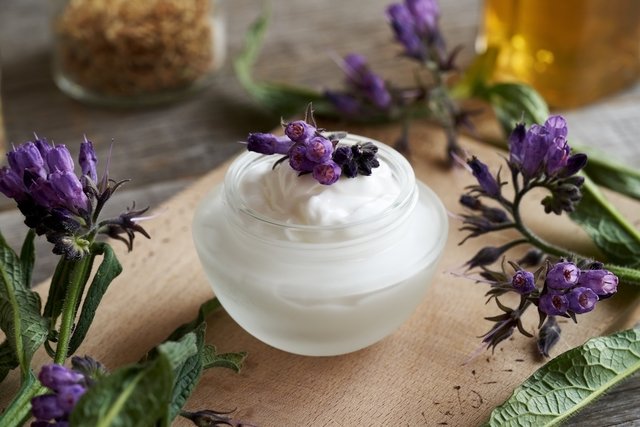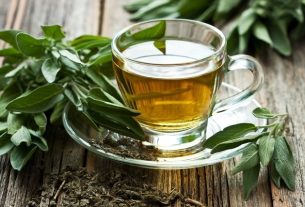Comfrey is a medicinal plant, of the species Symphytum officinale L. indicated to assist in the treatment of arthritis, rheumatism, bruises, fractures, skin inflammation or muscle pain, due to its astringent, healing and topical anti-inflammatory properties.
The normally used part of comfrey, also known as comfrey, Russian comfrey, vegetable milk or cow’s tongue, is the root or leaves for the preparation of compresses, ointment or poultices for external use.
Comfrey should be used under medical advice or from a herbalist and can be found in some health food stores and compounding pharmacies. for external use, and should not be ingested orally, as it is toxic.

What is it for
Comfrey is indicated for:
1. Relieve arthritis symptoms
Comfrey has allantoin, tannins and mucic acids in its composition with anti-inflammatory action that helps to alleviate the symptoms of arthritis, osteoarthritis or rheumatism such as inflammation, swelling or pain in the joints.
Due to its anti-inflammatory and blood circulation activating properties, comfrey can help combat muscle pain or strain, as well as back pain, relieving discomfort.
3. Relieve bruises
Comfrey can also help relieve pain from bruises or sprains following sports injuries or accidents, as well as skin bruises, as it improves local blood circulation, increases cell regeneration and promotes tissue healing.
4. Assist in the treatment of dislocation
As it contains allantoin, mucilage, saponins, tannins and pyrrolizidine alkaloids, comfrey can assist in the medical treatment of dislocation, accelerating recovery.
5. Relieve symptoms of bone fractures
Due to its anti-inflammatory and healing properties, comfrey when applied to the skin over the fractured region can help relieve pain or bruising caused by bone fractures.
6. Reduce skin inflammation
The allantoin and tannins in comfrey have anti-inflammatory and astringent effects, which can help reduce skin inflammation and aid in the treatment of dermatitis, pimples, psoriasis, boils or eczema.
7. Speed up healing
Comfrey also has healing properties, in addition to helping with the renewal of skin cells, and can be used to accelerate the healing of closed skin wounds.
How to use
Comfrey leaves and roots are used for therapeutic purposes, collected mainly when the plant is dry, for external application, i.e. Comfrey should not be taken orally as it is toxic.
1. Comfrey tea
Comfrey tea can be used in the form of compresses to help treat closed skin wounds, minor and minor fractures, or bruises, for example.
Ingredients
- 10 g of comfrey leaves;
- 500 mL of water.
Preparation mode
Bring the comfrey leaves and water to a boil, then turn off the heat and strain. Wait for it to warm, soak a clean, dry compress in this tea and apply it to the affected area.
2. Comfrey poultice
Comfrey poultice can be used for fractures, bruises, sprains or dislocations, for example.
Ingredients
- 110 g chopped comfrey root;
- 500 mL of water
Preparation mode
Place the ingredients in a pan and heat, letting it boil for about 20 minutes. Then strain, dip gauze or a clean, dry cloth in the warm solution and apply to the skin in the affected area. Do not apply to skin with open wounds.
2. Comfrey ointment
Comfrey ointment can be found in conventional or compounding pharmacies to help treat muscle or joint pain, post-traumatic pain, sprains or back pain, for example.
To use, apply a little of the ointment to the skin in the affected region, 2 to 4 times a day, as advised by your doctor or herbalist.
Possible side effects
The most common side effects of comfrey are liver damage, cirrhosis or liver cancer due to the presence of pyrrolozidine acid in its composition, which can be absorbed through the skin, especially when used on large areas of the skin or in quantities greater than those recommended. or for prolonged treatment time.
Furthermore, this plant can cause gastric irritation, liver damage or miscarriage if ingested.
Who shouldn’t use
Comfrey should not be used by children, the elderly, pregnant or breastfeeding women, or by people who are allergic to this plant.
Additionally, comfrey should not be used by people with liver and kidney disease or cancer.
Comfrey should also not be taken orally, nor used on large areas of skin or on open skin wounds..

Sign up for our newsletter and stay up to date with exclusive news
that can transform your routine!
Warning: Undefined array key "title" in /home/storelat/public_html/wp-content/plugins/link-whisper-premium/templates/frontend/related-posts.php on line 12
Warning: Undefined array key "title_tag" in /home/storelat/public_html/wp-content/plugins/link-whisper-premium/templates/frontend/related-posts.php on line 13



